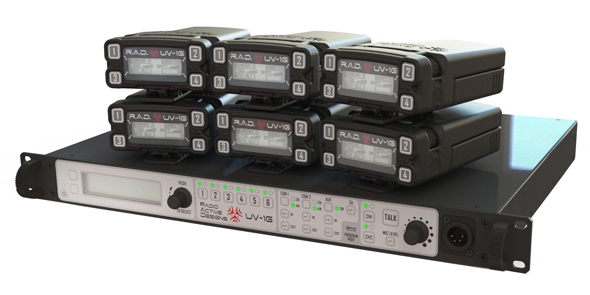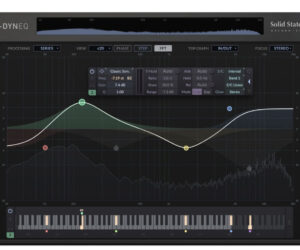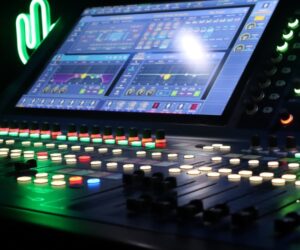The new Radio Active Designs (RAD) UV-1G wireless intercom system, featuring proprietary Enhanced Narrow Band technology to overcome the ongoing overcrowding of the RF spectrum while delivering exceptionally high audio quality and operational flexibility, is now shipping.
Enhanced Narrow Band technology, a unique modulation scheme, is 10 times more spectrally efficient than the current FM (Frequency Modulation) technology currently on the market. This proprietary approach is a form of Amplitude Modulation (AM), and it makes the transmitter’s occupied bandwidth—a critical figure in wireless frequency coordination—more predictable.
As a result, the UV-1G offers RF channels possessing an occupied bandwidth of a mere 25 kHz with the audio characteristics one would expect from a traditional FM system. In addition, the system utilizes the relatively unused VHF range for all belt pack portable devices, leading more room for operation of other wireless devices, such as wireless microphones and in-ear monitors.
James Stoffo, a principal of Radio Active Designs, explains: “A typical FM wireless intercom system requires 300 kHz of radio band to function properly. By implementing Enhanced Narrow Band, the UV-1G requires less than 30 kHz, and even if it performed in the UHF band, it would still be about 10 times more spectrally efficient.
“Thus by moving to the VHF band for the belt pack to base station frequencies, we can fit more than 30 base stations and 200 belt packs into less UHF spectrum than one FM wireless intercom system. From an RF coordinator’s perspective, this makes the UV-1G system more than 30 times more spectrally efficient than current UHF FM technology.”
Further, with the application of contemporary engineering techniques, the UV-1G implement a host of digital processing technologies that help produce sound quality with the warmth and intelligibility of an FM system.
Rather than pre-assign modes of operation for the user interface buttons, UV-1G belt packs include two programmable buttons that offer users a choice of multiple independent functions that can be quickly programmed. This can be done locally at the belt pack or via the system’s accompanying software program, and it means that a single technician can program an entire event’s worth of packs in a matter of minutes rather the hours it takes to manually program current technology for the same number of packs.
The headset connector on both the belt packs and the base station is field changeable between 5-pin female and 4-pin male to accommodate a variety of systems based mostly on the industry served. This is a solder-less connection that only requires a mini Philips screwdriver.
The belt packs also implement internal antennas to alleviate the problem of bending, breaking, or completely losing the antenna. In addition, they include a 1/8-inch stereo audio input so that monitor technicians may connect IEM receivers directly to their belt packs. This input can be used for any audio source, and there’s only one band split so that every belt pack works with every base station on the event.
To minimize rack space and maximize ISO channel operation, UV-1G systems allow for up to six belt packs per base station, and up to six base station links, for a total of 36 ISO channels between packs.
The UV-1G base station comes with two transmitter RF connectors so that it may immediately be connected to a combiner, such as the RAD TX-8, without any modification of hardware. The base station can also be connected to all standard wired communications systems, including Clear-Com, RTS and 4-wire systems.
“And it should be noted that the UV-1G can operate completely out of the portable white spaces device band, maximizing chances for success in even the most hostile RF environments,” Stoffo concludes.
















